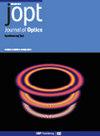Optical phase image encryption using stokes parameters and singular value decomposition
IF 2.7
4区 物理与天体物理
Q3 OPTICS
引用次数: 0
Abstract
In this paper, we propose an optical asymmetric phase image encryption method in which the vectorial light field is used to encode the data. In transverse plane, the vectorial light field has spatially varying polarization distributions where we are allowed to have a greater number of degrees of freedom. In this scheme, the input image is first phase encoded and then modulated by a phase encrypting key, synthesized from the speckles obtained by the scattering of Hermite–Gaussian beams. The modulated image is further processed using fractional Fourier transform with a specific order (α). A pixel scrambling operator is utilized to increase the randomness to further enhance the security and singular value decomposition approach is employed to add the nonlinearity in the encryption process. Now, the stokes parameters, i.e. S1 and S2 are calculated using the light intensities correspond to different polarizations. S1 is used as the encrypted image for transmission and S2 is reserved as one of the private decryption keys. The robustness of the proposed technique is tested against various existing attacks, such as known plaintext attack, chosen plaintext attack, and contamination attacks. Numerically simulated results validate the effectiveness and efficiency of the proposed method.利用斯托克斯参数和奇异值分解进行光学相位图像加密
本文提出了一种光学非对称相位图像加密方法,利用矢量光场对数据进行编码。在横向平面上,矢量光场具有空间变化的偏振分布,允许我们有更多的自由度。在该方案中,输入图像首先进行相位编码,然后用相位加密密钥进行调制,该密钥由 Hermite-Gaussian 光束散射产生的斑点合成。调制后的图像使用特定阶次(α)的分数傅里叶变换进行进一步处理。利用像素扰乱算子增加随机性,进一步提高安全性,并采用奇异值分解方法在加密过程中增加非线性。现在,利用对应于不同偏振的光强度来计算斯托克斯参数,即 S1 和 S2。S1 用作传输的加密图像,而 S2 则作为私人解密密钥之一。针对现有的各种攻击,如已知明文攻击、选择明文攻击和污染攻击,对所提出技术的鲁棒性进行了测试。数值模拟结果验证了所提方法的有效性和效率。
本文章由计算机程序翻译,如有差异,请以英文原文为准。
求助全文
约1分钟内获得全文
求助全文
来源期刊

Journal of Optics
OPTICS-
CiteScore
4.50
自引率
4.80%
发文量
237
审稿时长
1.9 months
期刊介绍:
Journal of Optics publishes new experimental and theoretical research across all areas of pure and applied optics, both modern and classical. Research areas are categorised as:
Nanophotonics and plasmonics
Metamaterials and structured photonic materials
Quantum photonics
Biophotonics
Light-matter interactions
Nonlinear and ultrafast optics
Propagation, diffraction and scattering
Optical communication
Integrated optics
Photovoltaics and energy harvesting
We discourage incremental advances, purely numerical simulations without any validation, or research without a strong optics advance, e.g. computer algorithms applied to optical and imaging processes, equipment designs or material fabrication.
 求助内容:
求助内容: 应助结果提醒方式:
应助结果提醒方式:


